Business Operations Analysis: Accounting, HR, Teamwork, and Leadership
VerifiedAdded on 2020/11/12
|8
|1910
|411
Report
AI Summary
This report provides a comprehensive overview of business operations, encompassing various aspects such as accounting, human resources, and team dynamics. It delves into the importance of accounting for business success, outlining the key functions of the HR department and employee legislation. The report analyzes the profit and loss account of Sainsbury, and explores the stages of team development, alongside different motivation theories and leadership styles, providing functional examples. The report also includes references to relevant books and journals, offering a well-rounded understanding of business operations and the factors influencing organizational productivity and success. The report is a valuable resource for students seeking to understand the intricacies of business management and operations, offering insights into accounting practices, HR functions, team dynamics, and effective leadership strategies.
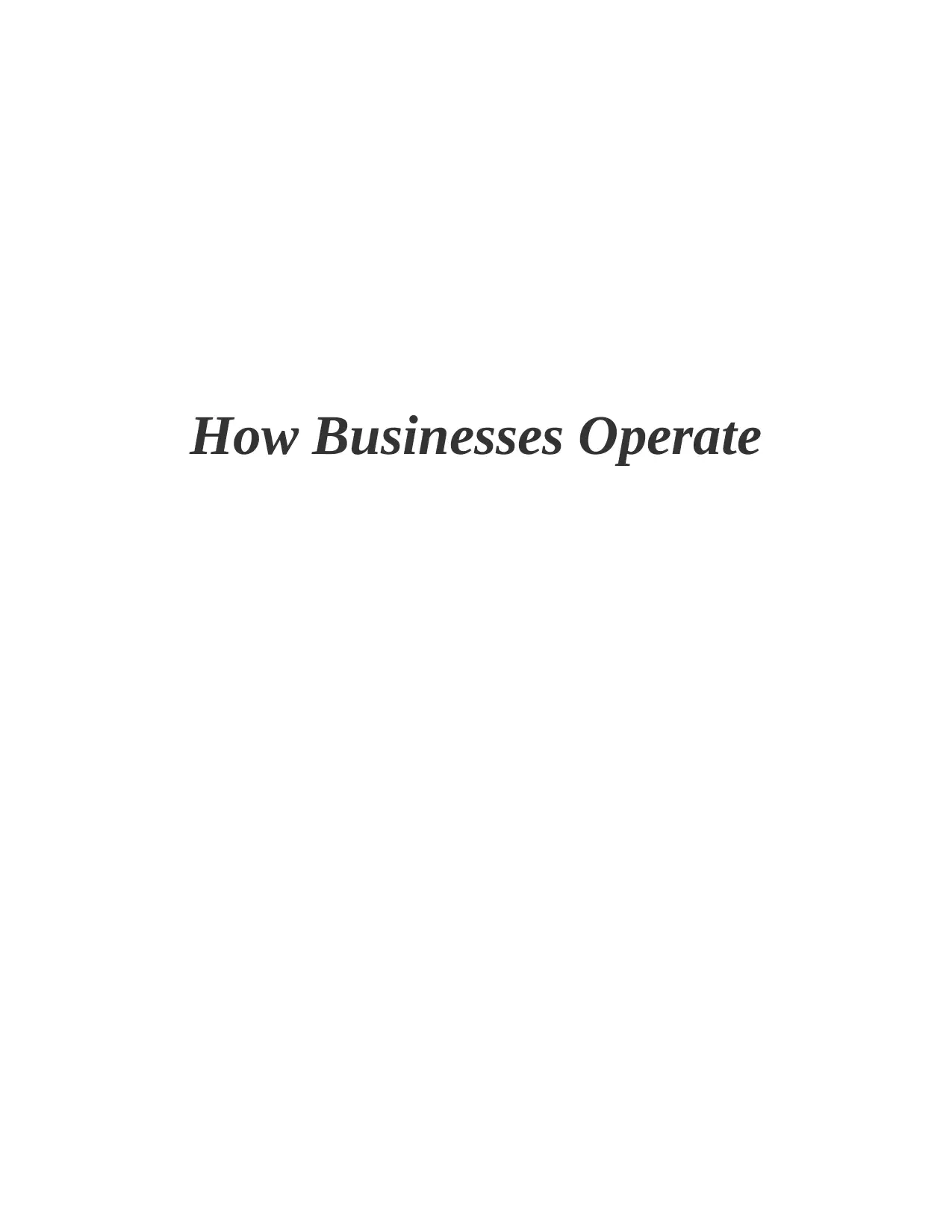
How Businesses Operate
Paraphrase This Document
Need a fresh take? Get an instant paraphrase of this document with our AI Paraphraser
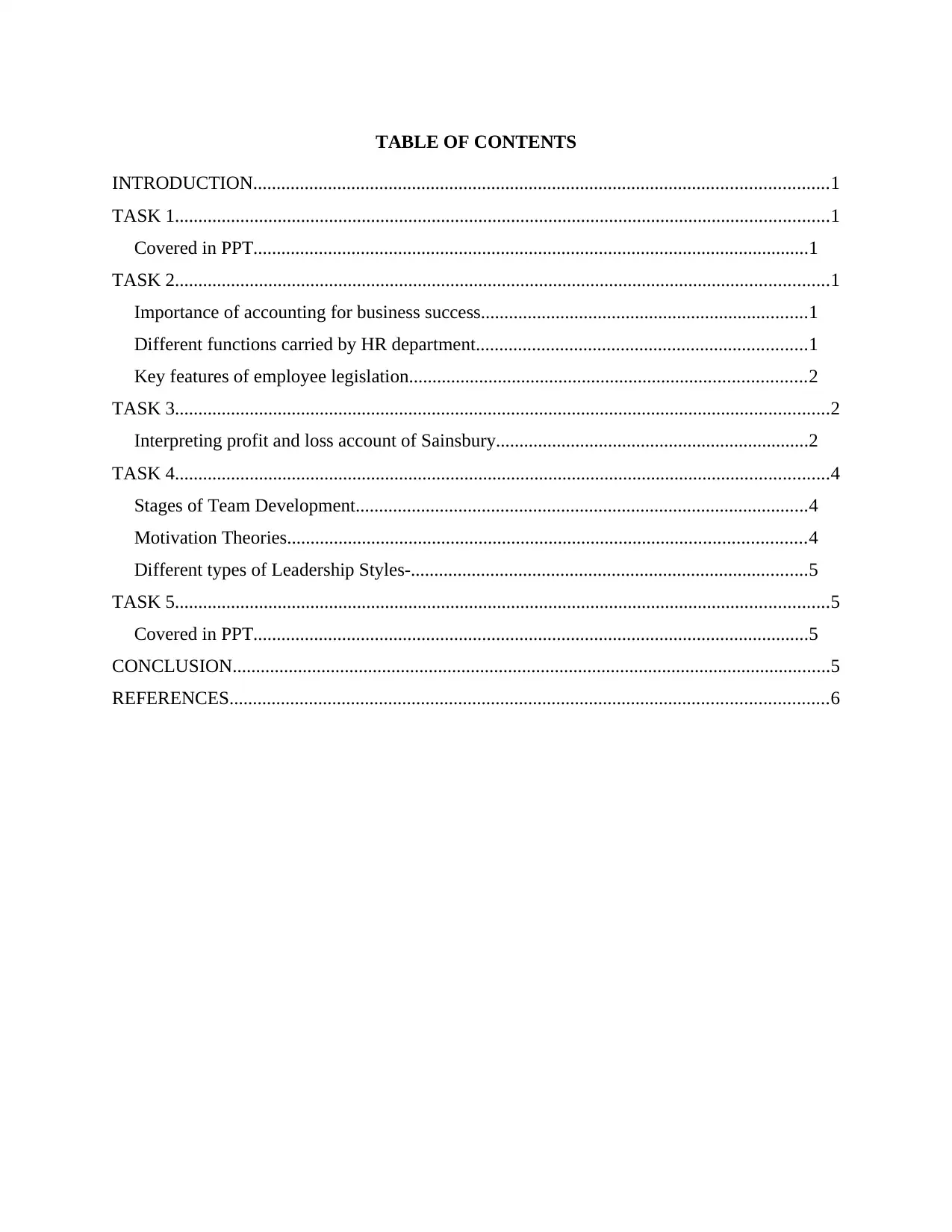
TABLE OF CONTENTS
INTRODUCTION...........................................................................................................................1
TASK 1............................................................................................................................................1
Covered in PPT.......................................................................................................................1
TASK 2............................................................................................................................................1
Importance of accounting for business success......................................................................1
Different functions carried by HR department.......................................................................1
Key features of employee legislation.....................................................................................2
TASK 3............................................................................................................................................2
Interpreting profit and loss account of Sainsbury...................................................................2
TASK 4............................................................................................................................................4
Stages of Team Development.................................................................................................4
Motivation Theories...............................................................................................................4
Different types of Leadership Styles-.....................................................................................5
TASK 5............................................................................................................................................5
Covered in PPT.......................................................................................................................5
CONCLUSION................................................................................................................................5
REFERENCES................................................................................................................................6
INTRODUCTION...........................................................................................................................1
TASK 1............................................................................................................................................1
Covered in PPT.......................................................................................................................1
TASK 2............................................................................................................................................1
Importance of accounting for business success......................................................................1
Different functions carried by HR department.......................................................................1
Key features of employee legislation.....................................................................................2
TASK 3............................................................................................................................................2
Interpreting profit and loss account of Sainsbury...................................................................2
TASK 4............................................................................................................................................4
Stages of Team Development.................................................................................................4
Motivation Theories...............................................................................................................4
Different types of Leadership Styles-.....................................................................................5
TASK 5............................................................................................................................................5
Covered in PPT.......................................................................................................................5
CONCLUSION................................................................................................................................5
REFERENCES................................................................................................................................6
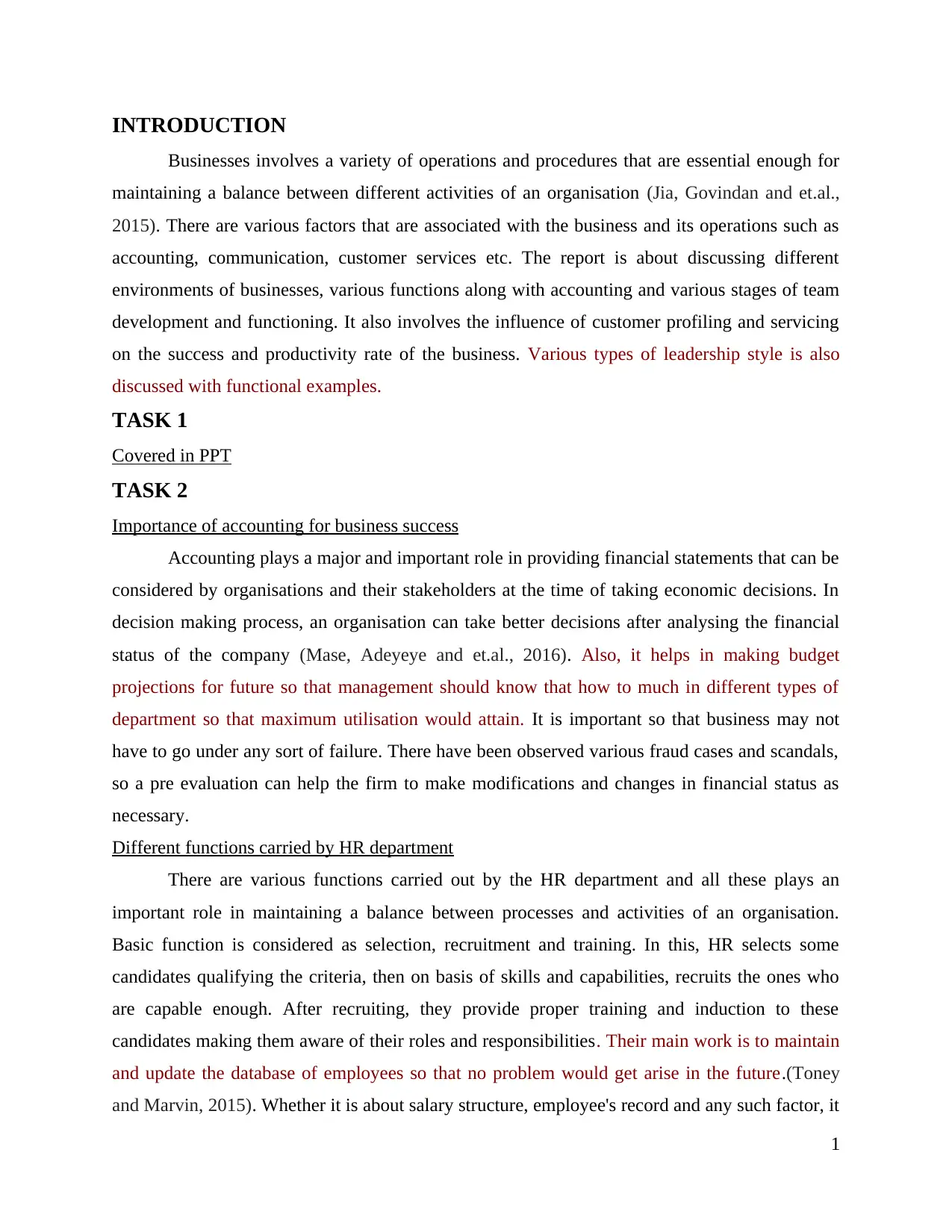
INTRODUCTION
Businesses involves a variety of operations and procedures that are essential enough for
maintaining a balance between different activities of an organisation (Jia, Govindan and et.al.,
2015). There are various factors that are associated with the business and its operations such as
accounting, communication, customer services etc. The report is about discussing different
environments of businesses, various functions along with accounting and various stages of team
development and functioning. It also involves the influence of customer profiling and servicing
on the success and productivity rate of the business. Various types of leadership style is also
discussed with functional examples.
TASK 1
Covered in PPT
TASK 2
Importance of accounting for business success
Accounting plays a major and important role in providing financial statements that can be
considered by organisations and their stakeholders at the time of taking economic decisions. In
decision making process, an organisation can take better decisions after analysing the financial
status of the company (Mase, Adeyeye and et.al., 2016). Also, it helps in making budget
projections for future so that management should know that how to much in different types of
department so that maximum utilisation would attain. It is important so that business may not
have to go under any sort of failure. There have been observed various fraud cases and scandals,
so a pre evaluation can help the firm to make modifications and changes in financial status as
necessary.
Different functions carried by HR department
There are various functions carried out by the HR department and all these plays an
important role in maintaining a balance between processes and activities of an organisation.
Basic function is considered as selection, recruitment and training. In this, HR selects some
candidates qualifying the criteria, then on basis of skills and capabilities, recruits the ones who
are capable enough. After recruiting, they provide proper training and induction to these
candidates making them aware of their roles and responsibilities. Their main work is to maintain
and update the database of employees so that no problem would get arise in the future.(Toney
and Marvin, 2015). Whether it is about salary structure, employee's record and any such factor, it
1
Businesses involves a variety of operations and procedures that are essential enough for
maintaining a balance between different activities of an organisation (Jia, Govindan and et.al.,
2015). There are various factors that are associated with the business and its operations such as
accounting, communication, customer services etc. The report is about discussing different
environments of businesses, various functions along with accounting and various stages of team
development and functioning. It also involves the influence of customer profiling and servicing
on the success and productivity rate of the business. Various types of leadership style is also
discussed with functional examples.
TASK 1
Covered in PPT
TASK 2
Importance of accounting for business success
Accounting plays a major and important role in providing financial statements that can be
considered by organisations and their stakeholders at the time of taking economic decisions. In
decision making process, an organisation can take better decisions after analysing the financial
status of the company (Mase, Adeyeye and et.al., 2016). Also, it helps in making budget
projections for future so that management should know that how to much in different types of
department so that maximum utilisation would attain. It is important so that business may not
have to go under any sort of failure. There have been observed various fraud cases and scandals,
so a pre evaluation can help the firm to make modifications and changes in financial status as
necessary.
Different functions carried by HR department
There are various functions carried out by the HR department and all these plays an
important role in maintaining a balance between processes and activities of an organisation.
Basic function is considered as selection, recruitment and training. In this, HR selects some
candidates qualifying the criteria, then on basis of skills and capabilities, recruits the ones who
are capable enough. After recruiting, they provide proper training and induction to these
candidates making them aware of their roles and responsibilities. Their main work is to maintain
and update the database of employees so that no problem would get arise in the future.(Toney
and Marvin, 2015). Whether it is about salary structure, employee's record and any such factor, it
1
⊘ This is a preview!⊘
Do you want full access?
Subscribe today to unlock all pages.

Trusted by 1+ million students worldwide
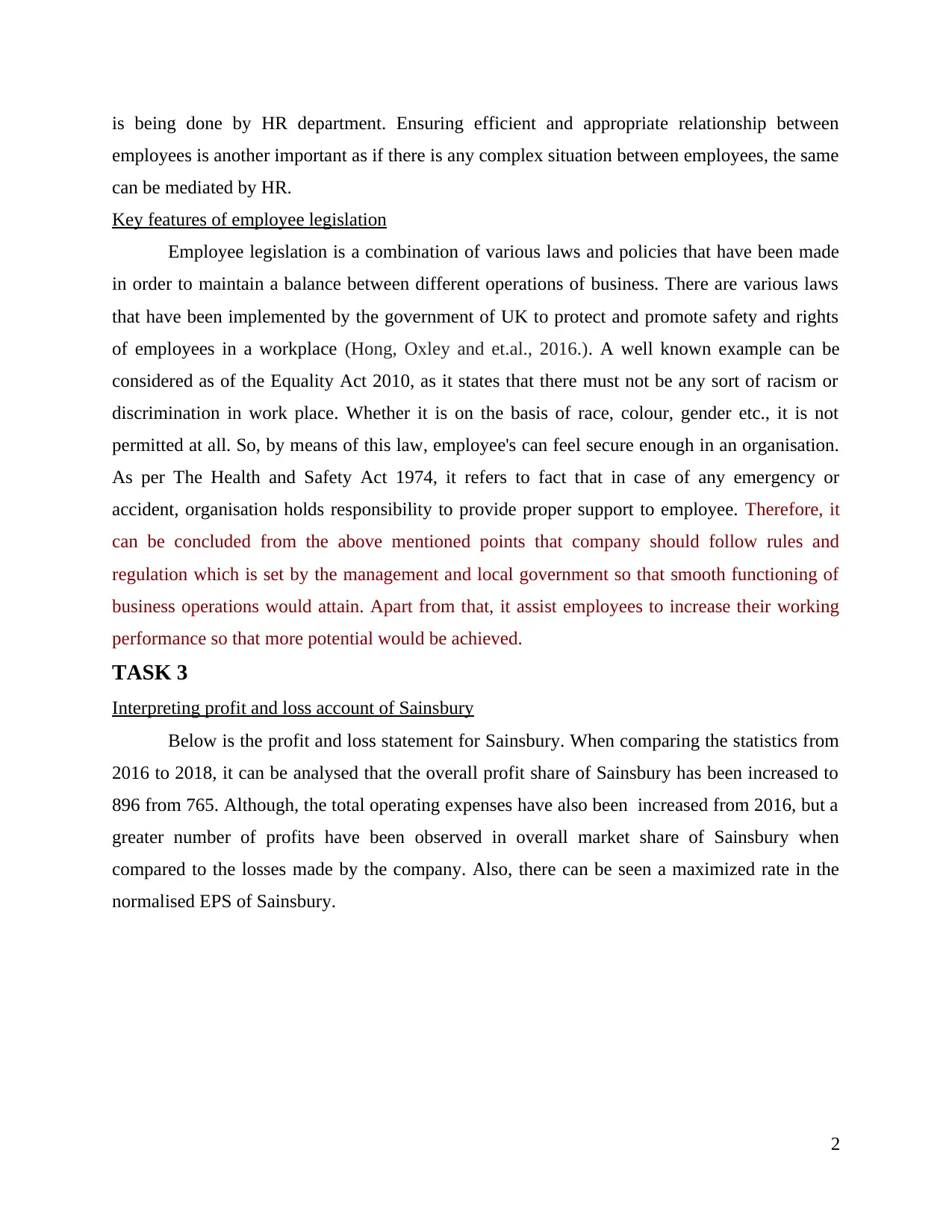
is being done by HR department. Ensuring efficient and appropriate relationship between
employees is another important as if there is any complex situation between employees, the same
can be mediated by HR.
Key features of employee legislation
Employee legislation is a combination of various laws and policies that have been made
in order to maintain a balance between different operations of business. There are various laws
that have been implemented by the government of UK to protect and promote safety and rights
of employees in a workplace (Hong, Oxley and et.al., 2016.). A well known example can be
considered as of the Equality Act 2010, as it states that there must not be any sort of racism or
discrimination in work place. Whether it is on the basis of race, colour, gender etc., it is not
permitted at all. So, by means of this law, employee's can feel secure enough in an organisation.
As per The Health and Safety Act 1974, it refers to fact that in case of any emergency or
accident, organisation holds responsibility to provide proper support to employee. Therefore, it
can be concluded from the above mentioned points that company should follow rules and
regulation which is set by the management and local government so that smooth functioning of
business operations would attain. Apart from that, it assist employees to increase their working
performance so that more potential would be achieved.
TASK 3
Interpreting profit and loss account of Sainsbury
Below is the profit and loss statement for Sainsbury. When comparing the statistics from
2016 to 2018, it can be analysed that the overall profit share of Sainsbury has been increased to
896 from 765. Although, the total operating expenses have also been increased from 2016, but a
greater number of profits have been observed in overall market share of Sainsbury when
compared to the losses made by the company. Also, there can be seen a maximized rate in the
normalised EPS of Sainsbury.
2
employees is another important as if there is any complex situation between employees, the same
can be mediated by HR.
Key features of employee legislation
Employee legislation is a combination of various laws and policies that have been made
in order to maintain a balance between different operations of business. There are various laws
that have been implemented by the government of UK to protect and promote safety and rights
of employees in a workplace (Hong, Oxley and et.al., 2016.). A well known example can be
considered as of the Equality Act 2010, as it states that there must not be any sort of racism or
discrimination in work place. Whether it is on the basis of race, colour, gender etc., it is not
permitted at all. So, by means of this law, employee's can feel secure enough in an organisation.
As per The Health and Safety Act 1974, it refers to fact that in case of any emergency or
accident, organisation holds responsibility to provide proper support to employee. Therefore, it
can be concluded from the above mentioned points that company should follow rules and
regulation which is set by the management and local government so that smooth functioning of
business operations would attain. Apart from that, it assist employees to increase their working
performance so that more potential would be achieved.
TASK 3
Interpreting profit and loss account of Sainsbury
Below is the profit and loss statement for Sainsbury. When comparing the statistics from
2016 to 2018, it can be analysed that the overall profit share of Sainsbury has been increased to
896 from 765. Although, the total operating expenses have also been increased from 2016, but a
greater number of profits have been observed in overall market share of Sainsbury when
compared to the losses made by the company. Also, there can be seen a maximized rate in the
normalised EPS of Sainsbury.
2
Paraphrase This Document
Need a fresh take? Get an instant paraphrase of this document with our AI Paraphraser
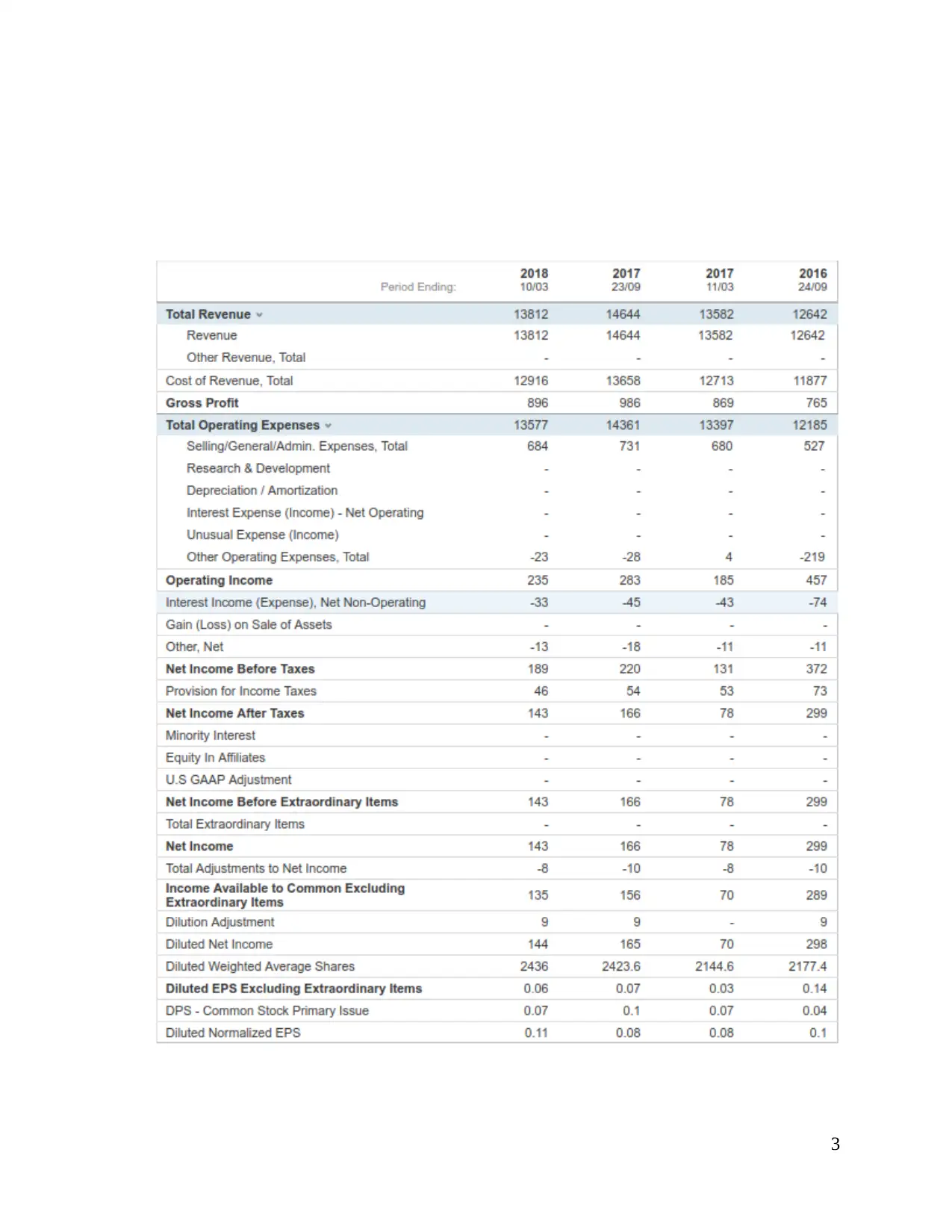
3
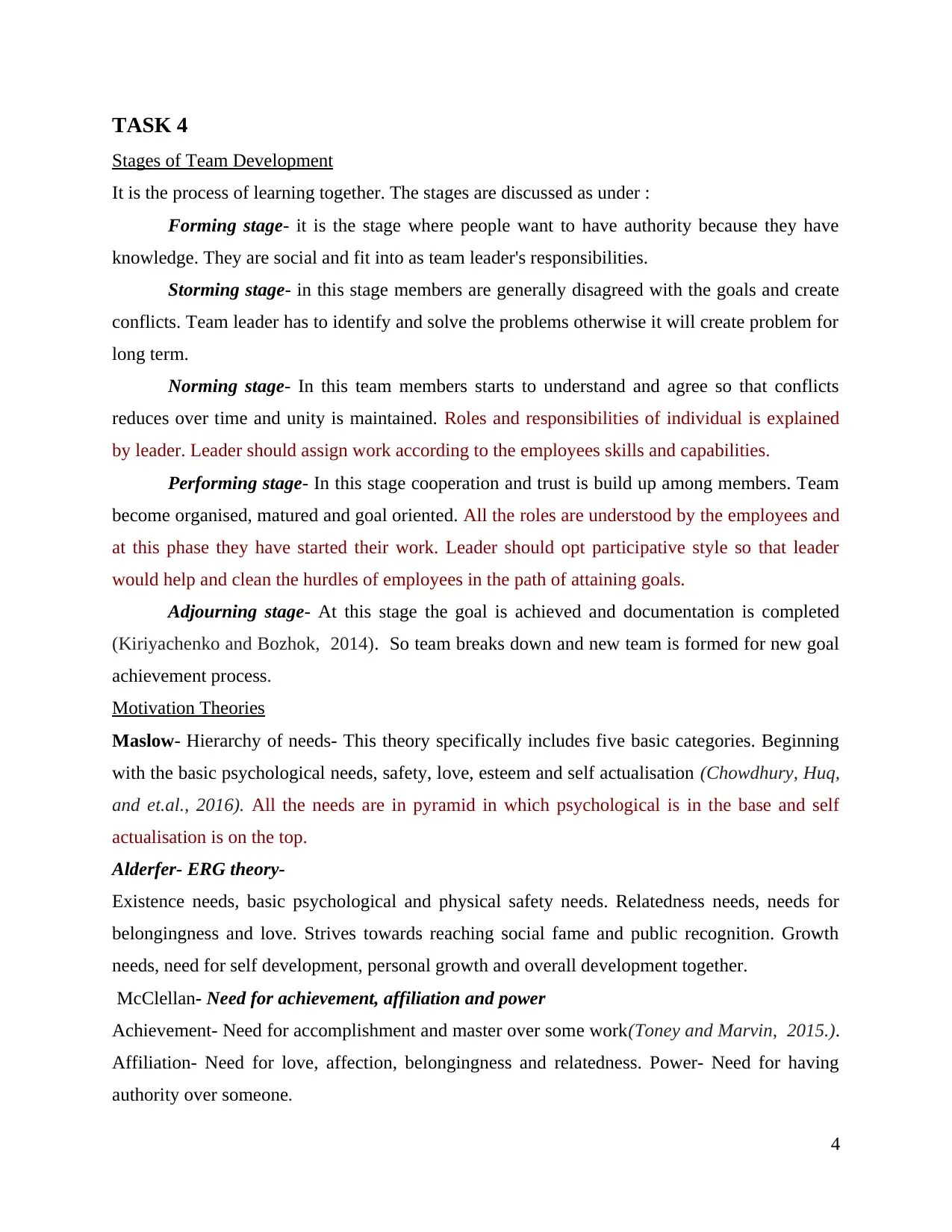
TASK 4
Stages of Team Development
It is the process of learning together. The stages are discussed as under :
Forming stage- it is the stage where people want to have authority because they have
knowledge. They are social and fit into as team leader's responsibilities.
Storming stage- in this stage members are generally disagreed with the goals and create
conflicts. Team leader has to identify and solve the problems otherwise it will create problem for
long term.
Norming stage- In this team members starts to understand and agree so that conflicts
reduces over time and unity is maintained. Roles and responsibilities of individual is explained
by leader. Leader should assign work according to the employees skills and capabilities.
Performing stage- In this stage cooperation and trust is build up among members. Team
become organised, matured and goal oriented. All the roles are understood by the employees and
at this phase they have started their work. Leader should opt participative style so that leader
would help and clean the hurdles of employees in the path of attaining goals.
Adjourning stage- At this stage the goal is achieved and documentation is completed
(Kiriyachenko and Bozhok, 2014). So team breaks down and new team is formed for new goal
achievement process.
Motivation Theories
Maslow- Hierarchy of needs- This theory specifically includes five basic categories. Beginning
with the basic psychological needs, safety, love, esteem and self actualisation (Chowdhury, Huq,
and et.al., 2016). All the needs are in pyramid in which psychological is in the base and self
actualisation is on the top.
Alderfer- ERG theory-
Existence needs, basic psychological and physical safety needs. Relatedness needs, needs for
belongingness and love. Strives towards reaching social fame and public recognition. Growth
needs, need for self development, personal growth and overall development together.
McClellan- Need for achievement, affiliation and power
Achievement- Need for accomplishment and master over some work(Toney and Marvin, 2015.).
Affiliation- Need for love, affection, belongingness and relatedness. Power- Need for having
authority over someone.
4
Stages of Team Development
It is the process of learning together. The stages are discussed as under :
Forming stage- it is the stage where people want to have authority because they have
knowledge. They are social and fit into as team leader's responsibilities.
Storming stage- in this stage members are generally disagreed with the goals and create
conflicts. Team leader has to identify and solve the problems otherwise it will create problem for
long term.
Norming stage- In this team members starts to understand and agree so that conflicts
reduces over time and unity is maintained. Roles and responsibilities of individual is explained
by leader. Leader should assign work according to the employees skills and capabilities.
Performing stage- In this stage cooperation and trust is build up among members. Team
become organised, matured and goal oriented. All the roles are understood by the employees and
at this phase they have started their work. Leader should opt participative style so that leader
would help and clean the hurdles of employees in the path of attaining goals.
Adjourning stage- At this stage the goal is achieved and documentation is completed
(Kiriyachenko and Bozhok, 2014). So team breaks down and new team is formed for new goal
achievement process.
Motivation Theories
Maslow- Hierarchy of needs- This theory specifically includes five basic categories. Beginning
with the basic psychological needs, safety, love, esteem and self actualisation (Chowdhury, Huq,
and et.al., 2016). All the needs are in pyramid in which psychological is in the base and self
actualisation is on the top.
Alderfer- ERG theory-
Existence needs, basic psychological and physical safety needs. Relatedness needs, needs for
belongingness and love. Strives towards reaching social fame and public recognition. Growth
needs, need for self development, personal growth and overall development together.
McClellan- Need for achievement, affiliation and power
Achievement- Need for accomplishment and master over some work(Toney and Marvin, 2015.).
Affiliation- Need for love, affection, belongingness and relatedness. Power- Need for having
authority over someone.
4
⊘ This is a preview!⊘
Do you want full access?
Subscribe today to unlock all pages.

Trusted by 1+ million students worldwide
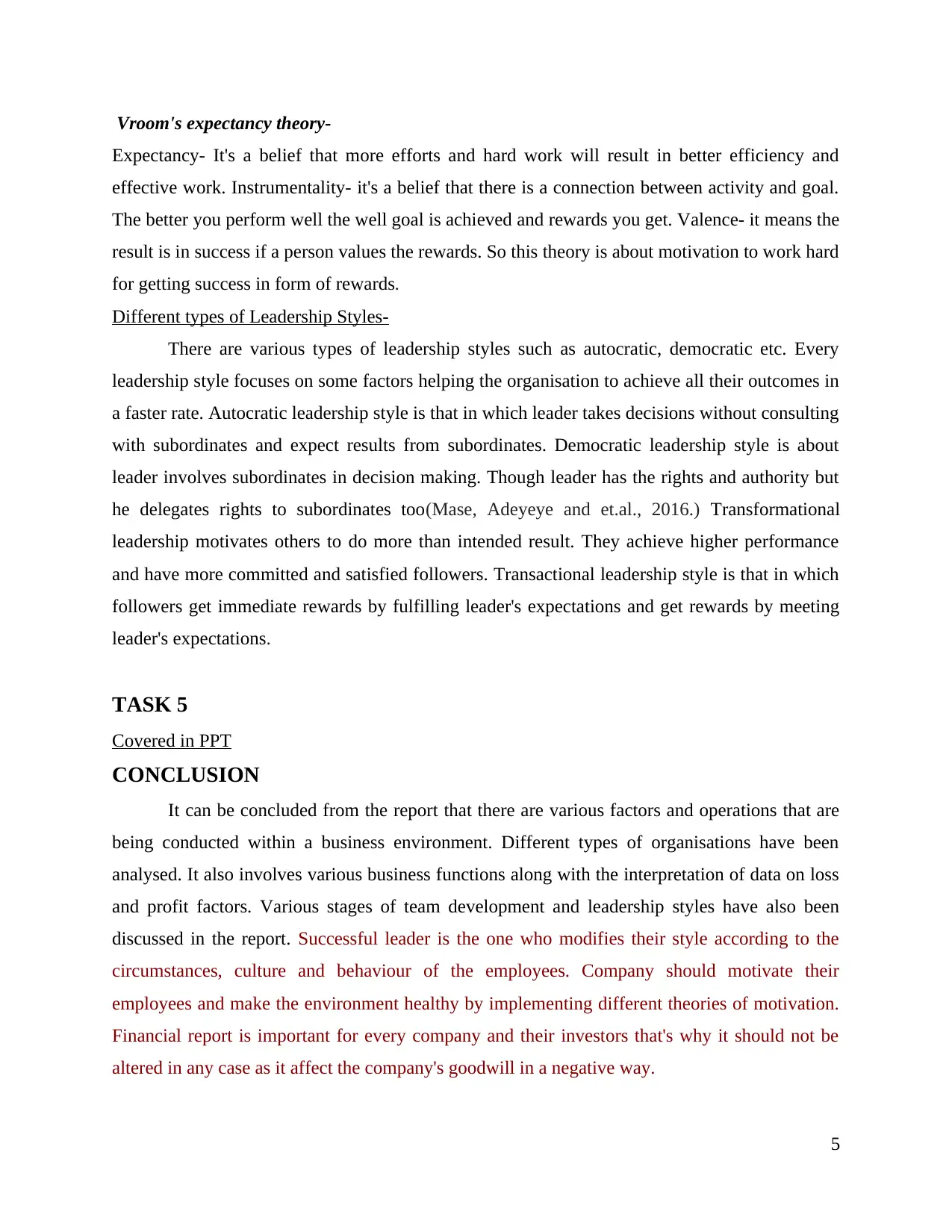
Vroom's expectancy theory-
Expectancy- It's a belief that more efforts and hard work will result in better efficiency and
effective work. Instrumentality- it's a belief that there is a connection between activity and goal.
The better you perform well the well goal is achieved and rewards you get. Valence- it means the
result is in success if a person values the rewards. So this theory is about motivation to work hard
for getting success in form of rewards.
Different types of Leadership Styles-
There are various types of leadership styles such as autocratic, democratic etc. Every
leadership style focuses on some factors helping the organisation to achieve all their outcomes in
a faster rate. Autocratic leadership style is that in which leader takes decisions without consulting
with subordinates and expect results from subordinates. Democratic leadership style is about
leader involves subordinates in decision making. Though leader has the rights and authority but
he delegates rights to subordinates too(Mase, Adeyeye and et.al., 2016.) Transformational
leadership motivates others to do more than intended result. They achieve higher performance
and have more committed and satisfied followers. Transactional leadership style is that in which
followers get immediate rewards by fulfilling leader's expectations and get rewards by meeting
leader's expectations.
TASK 5
Covered in PPT
CONCLUSION
It can be concluded from the report that there are various factors and operations that are
being conducted within a business environment. Different types of organisations have been
analysed. It also involves various business functions along with the interpretation of data on loss
and profit factors. Various stages of team development and leadership styles have also been
discussed in the report. Successful leader is the one who modifies their style according to the
circumstances, culture and behaviour of the employees. Company should motivate their
employees and make the environment healthy by implementing different theories of motivation.
Financial report is important for every company and their investors that's why it should not be
altered in any case as it affect the company's goodwill in a negative way.
5
Expectancy- It's a belief that more efforts and hard work will result in better efficiency and
effective work. Instrumentality- it's a belief that there is a connection between activity and goal.
The better you perform well the well goal is achieved and rewards you get. Valence- it means the
result is in success if a person values the rewards. So this theory is about motivation to work hard
for getting success in form of rewards.
Different types of Leadership Styles-
There are various types of leadership styles such as autocratic, democratic etc. Every
leadership style focuses on some factors helping the organisation to achieve all their outcomes in
a faster rate. Autocratic leadership style is that in which leader takes decisions without consulting
with subordinates and expect results from subordinates. Democratic leadership style is about
leader involves subordinates in decision making. Though leader has the rights and authority but
he delegates rights to subordinates too(Mase, Adeyeye and et.al., 2016.) Transformational
leadership motivates others to do more than intended result. They achieve higher performance
and have more committed and satisfied followers. Transactional leadership style is that in which
followers get immediate rewards by fulfilling leader's expectations and get rewards by meeting
leader's expectations.
TASK 5
Covered in PPT
CONCLUSION
It can be concluded from the report that there are various factors and operations that are
being conducted within a business environment. Different types of organisations have been
analysed. It also involves various business functions along with the interpretation of data on loss
and profit factors. Various stages of team development and leadership styles have also been
discussed in the report. Successful leader is the one who modifies their style according to the
circumstances, culture and behaviour of the employees. Company should motivate their
employees and make the environment healthy by implementing different theories of motivation.
Financial report is important for every company and their investors that's why it should not be
altered in any case as it affect the company's goodwill in a negative way.
5
Paraphrase This Document
Need a fresh take? Get an instant paraphrase of this document with our AI Paraphraser
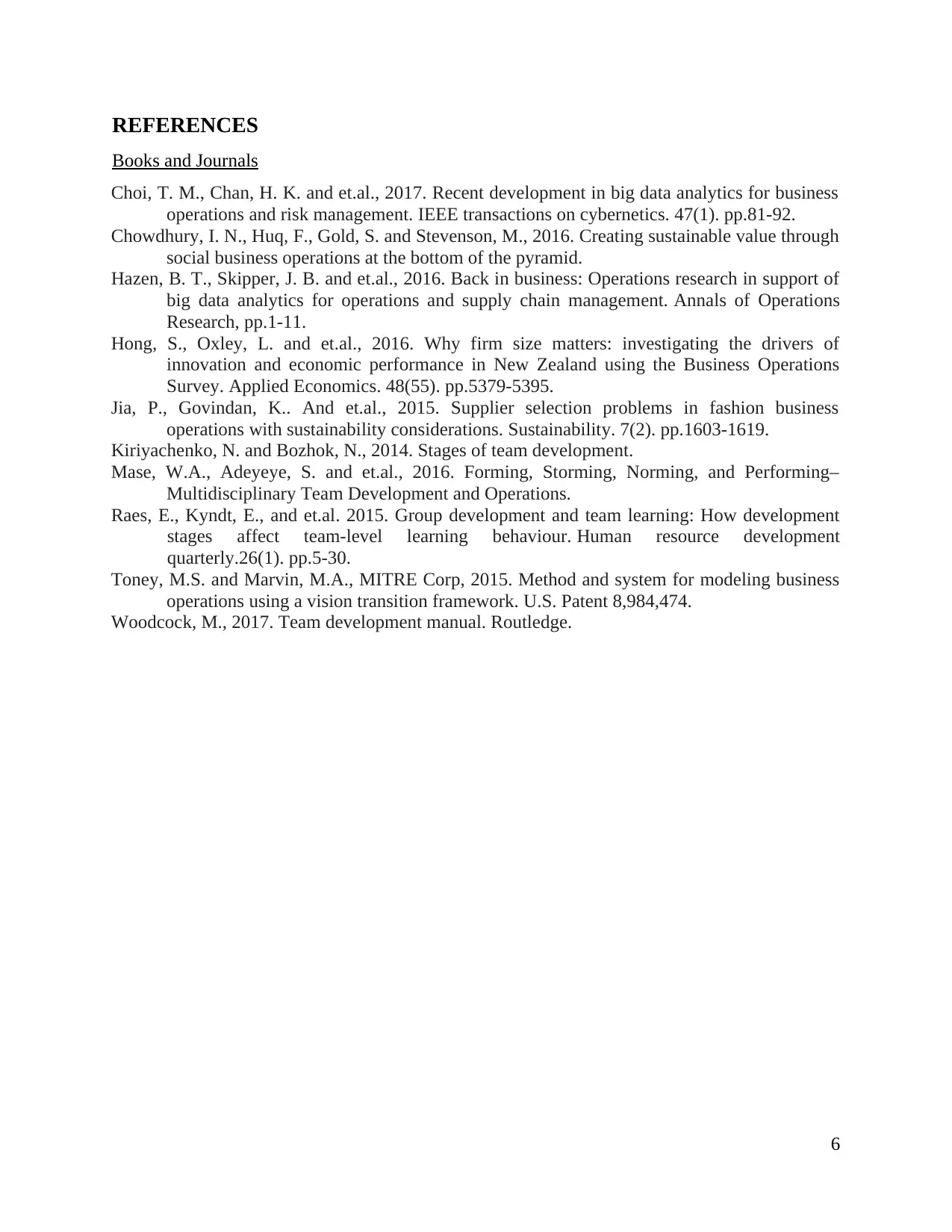
REFERENCES
Books and Journals
Choi, T. M., Chan, H. K. and et.al., 2017. Recent development in big data analytics for business
operations and risk management. IEEE transactions on cybernetics. 47(1). pp.81-92.
Chowdhury, I. N., Huq, F., Gold, S. and Stevenson, M., 2016. Creating sustainable value through
social business operations at the bottom of the pyramid.
Hazen, B. T., Skipper, J. B. and et.al., 2016. Back in business: Operations research in support of
big data analytics for operations and supply chain management. Annals of Operations
Research, pp.1-11.
Hong, S., Oxley, L. and et.al., 2016. Why firm size matters: investigating the drivers of
innovation and economic performance in New Zealand using the Business Operations
Survey. Applied Economics. 48(55). pp.5379-5395.
Jia, P., Govindan, K.. And et.al., 2015. Supplier selection problems in fashion business
operations with sustainability considerations. Sustainability. 7(2). pp.1603-1619.
Kiriyachenko, N. and Bozhok, N., 2014. Stages of team development.
Mase, W.A., Adeyeye, S. and et.al., 2016. Forming, Storming, Norming, and Performing–
Multidisciplinary Team Development and Operations.
Raes, E., Kyndt, E., and et.al. 2015. Group development and team learning: How development
stages affect team-level learning behaviour. Human resource development
quarterly.26(1). pp.5-30.
Toney, M.S. and Marvin, M.A., MITRE Corp, 2015. Method and system for modeling business
operations using a vision transition framework. U.S. Patent 8,984,474.
Woodcock, M., 2017. Team development manual. Routledge.
6
Books and Journals
Choi, T. M., Chan, H. K. and et.al., 2017. Recent development in big data analytics for business
operations and risk management. IEEE transactions on cybernetics. 47(1). pp.81-92.
Chowdhury, I. N., Huq, F., Gold, S. and Stevenson, M., 2016. Creating sustainable value through
social business operations at the bottom of the pyramid.
Hazen, B. T., Skipper, J. B. and et.al., 2016. Back in business: Operations research in support of
big data analytics for operations and supply chain management. Annals of Operations
Research, pp.1-11.
Hong, S., Oxley, L. and et.al., 2016. Why firm size matters: investigating the drivers of
innovation and economic performance in New Zealand using the Business Operations
Survey. Applied Economics. 48(55). pp.5379-5395.
Jia, P., Govindan, K.. And et.al., 2015. Supplier selection problems in fashion business
operations with sustainability considerations. Sustainability. 7(2). pp.1603-1619.
Kiriyachenko, N. and Bozhok, N., 2014. Stages of team development.
Mase, W.A., Adeyeye, S. and et.al., 2016. Forming, Storming, Norming, and Performing–
Multidisciplinary Team Development and Operations.
Raes, E., Kyndt, E., and et.al. 2015. Group development and team learning: How development
stages affect team-level learning behaviour. Human resource development
quarterly.26(1). pp.5-30.
Toney, M.S. and Marvin, M.A., MITRE Corp, 2015. Method and system for modeling business
operations using a vision transition framework. U.S. Patent 8,984,474.
Woodcock, M., 2017. Team development manual. Routledge.
6
1 out of 8
Related Documents
Your All-in-One AI-Powered Toolkit for Academic Success.
+13062052269
info@desklib.com
Available 24*7 on WhatsApp / Email
![[object Object]](/_next/static/media/star-bottom.7253800d.svg)
Unlock your academic potential
Copyright © 2020–2025 A2Z Services. All Rights Reserved. Developed and managed by ZUCOL.





